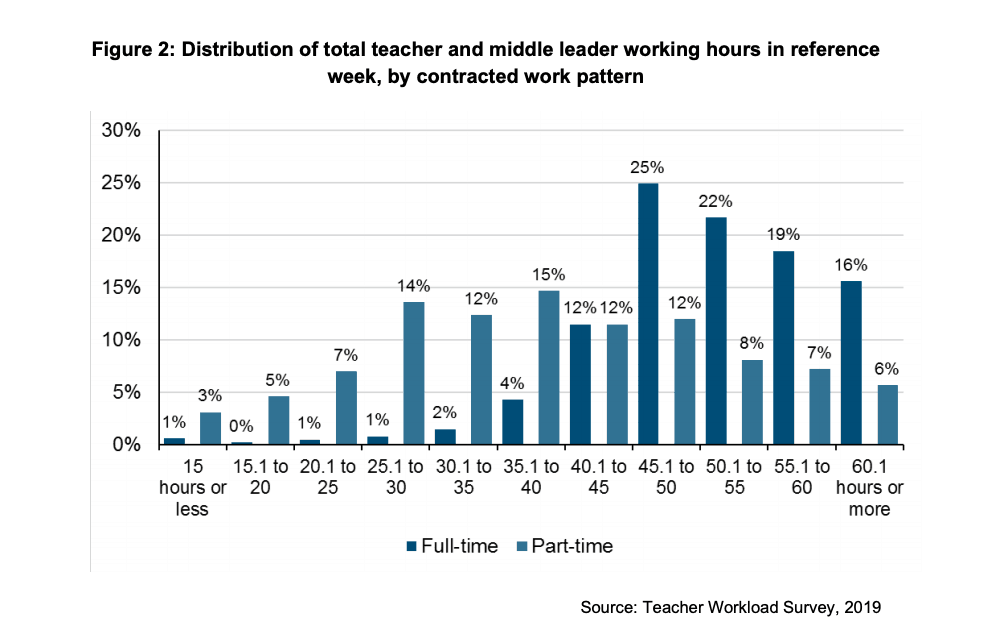(Quote source: https://www.glassdoor.com/Community/teachers-lounge/i-think-teaching-is-the-only-job-youhave-to-work-before-you-get-to-work-so-you-have-work-to-do-at-work-thenbecause-i-had-no-time)
As I sat scrolling through my social media feed this morning, a short Instagram reel caught my eye. It struck a chord for me, resonating with the challenges I faced in my time as a teacher. The reel (the text of which is quoted above), highlighted the unique predicament faced by teachers. This seemingly lighthearted observation encapsulated the harsh reality of the teaching profession today, a reality I experienced firsthand. My journey as a teacher was marked by dedication, I was fuelled by a passion for doing my best for young people to help them have the best chances in light. I believe this is a sentiment shared by most teachers. Yet, amidst the pursuit of excellence, I found myself grappling with an increasingly overwhelming workload that seemed insurmountable. The lack of clear boundaries, the perpetual cycle of planning and paperwork, the implicit expectation of working well beyond contracted hours was consistently modelled by my managers and permeated my experience. Despite pouring my heart and soul into my role, I couldn’t escape teacher burnout. This isn’t just my story – it’s a narrative shared by countless teachers.
Background to the issue
The challenges faced by teachers regarding workload have been extensively documented and scrutinised in recent years, shedding light on the pervasive nature of this issue within the education sector. According to a report by Schools Week, the government’s efforts to alleviate teacher workload have been met with limited success, with progress stagnating despite sustained initiatives. Despite the government’s pledge to reduce workload by five hours per week, the latest findings from the Department for Education’s (DfE) “Working Lives of Teachers and Leaders” report reveal a stark reality. Over two in five school leaders reported working at least 60 hours in a week, equivalent to five 12-hour days, while a significant proportion of teachers reported similar gruelling hours. Despite incremental decreases in average working hours in previous years, the recent trend indicates a concerning reversal, with teachers’ average working week inching closer to previous levels.
Moreover, the report highlights the disproportionate amount of time teachers spend on administrative tasks compared to actual teaching. Two-thirds of teachers reported spending more than half of their working time on non-teaching tasks, with general administrative work cited as the most time-consuming activity. This administrative burden not only detracts from valuable teaching time but also contributes to the pervasive issue of teacher burnout and dissatisfaction.

The toll of excessive workload on teachers’ well-being and mental health is evident, with one in three teachers and leaders considering leaving the state school sector within a year. High workload, government initiatives, and other pressures related to pupil outcomes rank among the top reasons cited for contemplating exit from the profession. These findings underscore the urgent need for comprehensive strategies to address the systemic factors contributing to teacher workload and retention challenges.
In addition, the report highlights disparities in job satisfaction and dissatisfaction with national changes to teacher pay, further exacerbating concerns about the overall morale and motivation of educators. Flexible working arrangements, touted as a potential solution to achieve a better work-life balance, are hindered by perceived incompatibility with the teaching career and concerns about their impact on career progression. Moreover, inadequate training and professional development opportunities, coupled with barriers such as workload and cost, impede educators’ ability to enhance their teaching skills effectively.
Tips for teachers to reduce workload
In response to the mounting workload pressures, teachers are seeking ways to alleviate the burden and reclaim control over their professional lives. Here are ten “practical” tips regularly suggested for teachers to reduce their workload:
- Prioritise tasks and focus on essential responsibilities: Identify tasks that directly contribute to student learning outcomes and prioritise them over non-essential administrative duties. By focusing on essential responsibilities, teachers can allocate their time and energy more effectively.
- Streamline administrative processes and minimise paperwork: Evaluate existing administrative procedures and identify opportunities to streamline processes. Utilise digital platforms and tools to reduce paperwork and automate routine tasks such as attendance tracking and data recording.
- Embrace technology to automate tasks and enhance efficiency: Explore technology solutions that can automate repetitive tasks and streamline classroom management. Adopting digital tools for lesson planning, marking, and communication can save time and enhance efficiency in teaching practices.
- Collaborate with colleagues to share resources and lesson planning: Foster a culture of collaboration among colleagues to share resources, ideas, and best practices. Collaborative lesson planning allows teachers to leverage each other’s expertise and resources, reducing individual workload and enhancing instructional quality.
- Set boundaries and allocate dedicated time for planning and preparation: Establish clear boundaries between work and personal time to prevent overwork and burnout. Allocate dedicated time for planning and preparation, to ensure you have adequate time to create high-quality lesson plans and materials.
- Utilise peer and self-assessment strategies to reduce marking time: Implement peer and self-assessment strategies to involve students in the assessment process and reduce the burden of marking. Encouraging students to provide feedback on their own work and that of their peers can save time and promote student engagement.
- Implement flexible working arrangements to achieve a better work-life balance: Advocate for flexible working arrangements that accommodate individual needs and preferences. Flexible scheduling, work-from-home options, and job-sharing arrangements can support a better work-life balance and enhance teacher well-being.
- Seek professional development opportunities to enhance teaching skills: Complete professional development opportunities to continuously improve teaching skills and stay updated on best practices. Participating in workshops, conferences, and online courses can equip teachers with new strategies and resources to effectively manage workload and enhance instructional effectiveness.
- Advocate for supportive policies and practices within the school community: Engage in advocacy efforts to promote supportive policies and practices within the school community. Collaborate with school leaders, policymakers, unions, and education stakeholders to address workload issues and advocate for policies that prioritise teacher well-being and professional growth.
- Prioritise self-care and well-being to maintain resilience and prevent burnout: Make self-care and well-being a priority to maintain resilience and prevent burnout. Incorporate regular exercise, mindfulness practices, and stress-management techniques into daily routines to support overall well-being and enhance resilience in managing workload challenges.

So what's next?
While these tips offer some practical strategies for managing workload, they do not address the systemic issues underlying the teacher workload crisis. In fact, many of them involve suggesting teachers take on more work in an effort to improve things – when so many teachers are already at breaking point, suggesting that they do more to improve their work-life balance is frankly dismaying. This is not something teachers are able to fix for themselves. The staggering statistic of a 22000% rise (yes, you read that correctly 700 to 155,000) in just 4 years in membership in a Facebook group dedicated to supporting teachers leaving the profession speaks volumes about the severity of the issue. Despite efforts to reduce workload, the relentless demands of the profession continue to take a toll on educators, jeopardising their well-being and the quality of education they provide. In addition, I recently heard of an inner city school of approximately 2000 students who have one Head of Science and no other permanent member of science teaching staff, relying on supply teachers instead. We are letting our children down by not addressing it.
As teachers, we cannot afford to ignore the pressing issue of teacher workload any longer. It’s time for collective action to address the root causes of the crisis and create a more sustainable and supportive environment for teachers. School leaders, policymakers, unions, and educational stakeholders must collaborate to implement systemic changes that prioritise teacher well-being and professional fulfilment. Additionally, educators must advocate for themselves and each other, demanding the recognition, support, and resources they need to thrive in their roles. Together, let us stand in solidarity and work towards a future where teachers are valued, supported, and empowered to fulfil their vital role in shaping the next generation.
Support for teachers

In the face of mounting workload pressures and the toll on mental health, it’s essential for teachers to prioritise self-care and seek support when needed. Here are some resources to call on if you are struggling at this time:
- Education Support: Provides confidential emotional support, counselling, and practical advice for teachers experiencing stress and mental health challenges.
- Local NHS talking therapies: Offers free, confidential support for individuals struggling with mental health issues, including anxiety and depression.
- Your GP: Provides medical support and referrals to mental health services for individuals experiencing mental health challenges.
- Friends and supportive networks: Reach out to trusted friends, colleagues, and support networks for emotional support and understanding.
- Online Communities: Join social media groups and online communities for teachers to connect with peers, share experiences, and seek advice and support.
- The Samaritans: Offers confidential emotional support 24/7 for individuals experiencing distress or despair.
Remember, you are not alone, you are loved and you are irreplaceable in this world.




